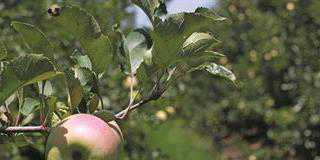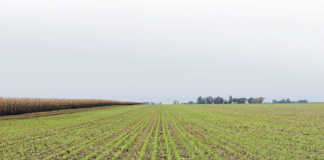Using cowpeas in his fodder flow, he strengthened his livestock component and moved away from monocropping maize. Annelie Coleman reports.
Cobus van Coller has
successfully incorporated cowpeas into his livestock enterprise on a Viljoenskroon farm, a traditional maize-producing area of the Free State. Cobus, an electronic engineer who started farming 11 years ago, soon realised that he couldn’t survive on maize alone. His maize enterprise required high inputs and profits were dwindling, so Cobus was forced to find alternatives which would add value on a farm level and limit economic risk.
“Monocropping just didn’t work any longer,” says Cobus. “I realised that diversifying from maize was essential. Livestock keeps its value and is a relatively inexpensive way to diversify. You don’t need expensive equipment that depreciates in value. But I needed something to grow on fallow lands as a cover crop and for animal feed. Nobody had ever used cowpeas for this in our area, and virtually no research has been done on it in South Africa’s western grain production areas. “A neighbour who planted cowpeas ona small scale gave me the idea, and I decided to use it in rotation with my other crops. Cowpeas rotated with grazing maize have carried me over the years. My enterprise’s farming turnover now consists of 70% maize grain, 13,3% sunflower, 4,2% cowpeas, 2,2 % grazing and silage maize, and 10% livestock.”
In 2005, Cobus started planting cowpeas in rotation with maize and sunflowers, despite the general belief that it wasn’t suited to the north-western Free State. To date, he has converted some 13% of his land from maize to cowpeas. This, as well as planting grazing maize, lets him run a flock of 900 commercial Mutton Merino sheep and 150 Simmentaler-cross cattle. He also runs a feedlot with a capacity for 2 000 lambs. The cattle are run on veld and fed maize silage, while he beneficiates his own maize grain through the feedlot. “The more grain I can use for livestock, the better,” he explains. “The production price for maize is now around R1/kg, and 3kg of maize produces 1kg of mutton, which sells at R35/kg.”
A versatile crop
Cowpea is a particularly versatile crop and can be planted as pasture for grazing or baled, makes excellent silage and can be used as a cover crop for rotation. It’s also a legume, so it fixes nitrogen in the soil, benefiting follow-up crops. The maize yield on Cobus’s farm has increased by up to 1,5t/ha because of the extra nitrogen. “Cowpea is well-adapted to our area,” he says. “I grow the Bechuanaland White cultivar from Klein Karoo Seed Marketing. It’s a medium scrambler. “Minimum till reduces input costs. An ordinary maize planter that can accommodate soya bean seed can plant cowpea seed. I don’t apply fertiliser, apart from extra potassium in the following year, as cowpeas extract large amounts of potassium from the soil, which is mainly the Avalon type. “I plant about 10kg/ha to 12kg/ha of seed from mid-October to mid-January, as early as possible, depending on the rain.”
Low inputs
The input cost for cowpeas is relatively low. In 2009 it was R112/ha for seed, R15/ha for inoculation, R110/ha for herbicide including Roundup, and R70/ha for diesel – totalling R307/ha.
Cowpeas must also be inoculated with the appropriate Rhizobium inoculant to bind atmospheric nitrogen from the air to form amino acids, which are the building blocks for plant protein.
Cobus uses the cowpeas on the lands as grazing for sheep and cattle.
“The low input costs for cowpeas coupled with grazing maize increases the overall profitability of sheep in particular,” he says. “And I think the input costs may be even lower this year due to the exchange rate and lower fuel price.
“It’s expensive to bale or ensile cowpeas, but using it on the lands eliminates these costs. I haven’t established the carrying capacity, but with good rainfall the cowpeas grow hip-high. In dryer conditions it obviously doesn’t grow so well, but it’s still adequate for my needs. “Sheep and cattle graze rotationally – a maximum of two of the six camps at any give stage – on the cowpeas as soon as autumn colours start showing (mid-February to end April) or the pods have peas in the soft-dough stage. When a cowpea camp has been grazed down halfway, the animals go to the next camp.” To ensure sufficient regrowth in autumn before the frost sets in, Cobus plants as early as possible in summer. An energy lick supplements the cowpea grazing, and Cobus also provides Voermol Landelek lick in summer and a protein lick in winter.
The road ahead
“Farming is a business,” says Cobus. “Everything must contribute to the enterprise’s profitability. The livestock component ensures a reliable cash flow.“Incorporating cowpeas and grazing maize has increased the profitability of sheep farming so much that I plan to expand my sheep flock to between 2 000 and 3 000 over the next five years. “This costs money and I’d rather expand my flock through breeding up, so I select ruthlessly for meat production and multiple births. The average lambing rate is 140% and the weaning rate 120%. I also want to expand the cattle herd to 400 because economy of scale is vital for sustainability. “My advice to fellow farmers is not to rush into anything. Start slowly and develop your own system to suit your own needs – no two farming enterprises are alike. In my case, cowpeas were the solution to my need to diversify, despite advice to the contrary.”
Call Cobus van Coller on 082 561 6375. |fw













